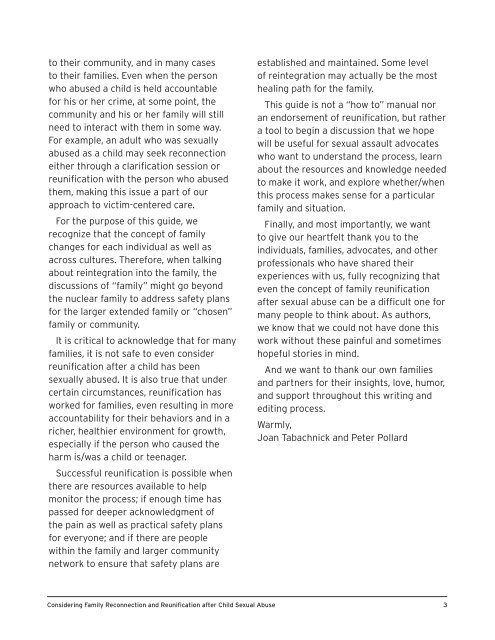Considering Family Reconnection and Reunification after Child Sexual Abuse
28UugZC
28UugZC
You also want an ePaper? Increase the reach of your titles
YUMPU automatically turns print PDFs into web optimized ePapers that Google loves.
to their community, <strong>and</strong> in many cases<br />
to their families. Even when the person<br />
who abused a child is held accountable<br />
for his or her crime, at some point, the<br />
community <strong>and</strong> his or her family will still<br />
need to interact with them in some way.<br />
For example, an adult who was sexually<br />
abused as a child may seek reconnection<br />
either through a clarification session or<br />
reunification with the person who abused<br />
them, making this issue a part of our<br />
approach to victim-centered care.<br />
For the purpose of this guide, we<br />
recognize that the concept of family<br />
changes for each individual as well as<br />
across cultures. Therefore, when talking<br />
about reintegration into the family, the<br />
discussions of “family” might go beyond<br />
the nuclear family to address safety plans<br />
for the larger extended family or “chosen”<br />
family or community.<br />
It is critical to acknowledge that for many<br />
families, it is not safe to even consider<br />
reunification <strong>after</strong> a child has been<br />
sexually abused. It is also true that under<br />
certain circumstances, reunification has<br />
worked for families, even resulting in more<br />
accountability for their behaviors <strong>and</strong> in a<br />
richer, healthier environment for growth,<br />
especially if the person who caused the<br />
harm is/was a child or teenager.<br />
Successful reunification is possible when<br />
there are resources available to help<br />
monitor the process; if enough time has<br />
passed for deeper acknowledgment of<br />
the pain as well as practical safety plans<br />
for everyone; <strong>and</strong> if there are people<br />
within the family <strong>and</strong> larger community<br />
network to ensure that safety plans are<br />
established <strong>and</strong> maintained. Some level<br />
of reintegration may actually be the most<br />
healing path for the family.<br />
This guide is not a “how to” manual nor<br />
an endorsement of reunification, but rather<br />
a tool to begin a discussion that we hope<br />
will be useful for sexual assault advocates<br />
who want to underst<strong>and</strong> the process, learn<br />
about the resources <strong>and</strong> knowledge needed<br />
to make it work, <strong>and</strong> explore whether/when<br />
this process makes sense for a particular<br />
family <strong>and</strong> situation.<br />
Finally, <strong>and</strong> most importantly, we want<br />
to give our heartfelt thank you to the<br />
individuals, families, advocates, <strong>and</strong> other<br />
professionals who have shared their<br />
experiences with us, fully recognizing that<br />
even the concept of family reunification<br />
<strong>after</strong> sexual abuse can be a difficult one for<br />
many people to think about. As authors,<br />
we know that we could not have done this<br />
work without these painful <strong>and</strong> sometimes<br />
hopeful stories in mind.<br />
And we want to thank our own families<br />
<strong>and</strong> partners for their insights, love, humor,<br />
<strong>and</strong> support throughout this writing <strong>and</strong><br />
editing process.<br />
Warmly,<br />
Joan Tabachnick <strong>and</strong> Peter Pollard<br />
<strong>Considering</strong> <strong>Family</strong> <strong>Reconnection</strong> <strong>and</strong> <strong>Reunification</strong> <strong>after</strong> <strong>Child</strong> <strong>Sexual</strong> <strong>Abuse</strong> 3


